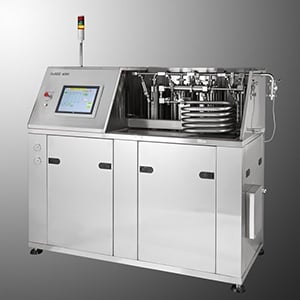
The intensive mixing process has existed for decades, beginning with the advent of the blender by Stephen Poplawski in 1922. (1) The equipment has since evolved to something more complex and with more potential functions; users now have the option of a basic blender for simple kitchen processes, or an intensive mixing homogenizer designed for laboratory use. Yet while the general public is familiar with the functions and appropriate occasions for blender use, the same is not true for a homogenizer. Below is a compilation of homogenizer functions, potential uses, and the people/industries who should consider acquiring one.
Homogenization works by forcing the sample through a narrow space. Multiple forces (including turbulence and cavitation) in addition to high pressure, can act on the sample to create a high quality product. Specifically because of its powerful pressure, homogenization is frequently used for particle size reduction or cell lysis. These processes can result in a valuable yield, from creating cell lysates containing valuable proteins or DNA to producing emulsions, dispersions, and suspensions. Although a myriad of other mixing machines exist, the homogenizer is superior for multiple reasons. Not only is it easily scalable, but it also uses multiple mechanical forces (as opposed to one, which is the case for most mixing equipment); this results in a stable, uniform, and consistent product.
Multiple industries can, and do, take advantage of the impressive homogenizer capabilities. In the pharmaceutical industry, researchers use the scalable homogenizer first during laboratory research, and then in clinical trials and manufacturing. Its yields are typically incorporated into critical products like vaccines, antibiotics, cancer treatment, and pharmaceutical creams. In the beverage industry, homogenized milk has a longer shelf life and is more stable and physically attractive. And in the biotech industry, particle size reduction can yield nanoparticles and other new innovations. The foods and chemical industries also see significant homogenizer use.
Pion: The Homogenizer Advantage
As you work to determine which high-pressure homogenizer brand and model will be best suited for your laboratory, begin your search with Pion's BEE brand technology. We are globally recognized among laboratory managers and researchers for our high quality products and excellent customer support. Cell lysis and particle size reduction are two of a variety of applications for Pion's homogenizers; nano/micro emulsions, lipids, suspensions, and dispersions are also easily achievable.
Importantly, Pion's BEE brand homogenizers can achieve consistent particle sizes at or below 100 nm, a key benefit for products that require smaller droplet sizes. Additionally, the homogenizer processes can be controlled to suit your product, which will allow you to customize to your cell type. And finally, the equipment is easy to use, produces higher yield in less time, and achieves results that are reproducible and scalable.
Learn more about how Pion's BEE brand homogenizers can improve your experimentation by contacting us today!

